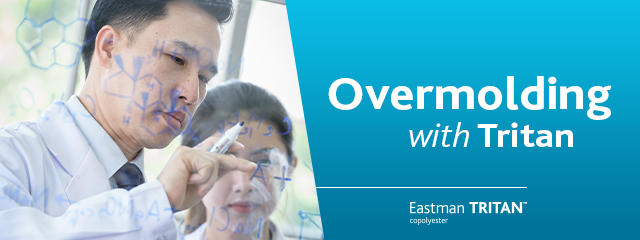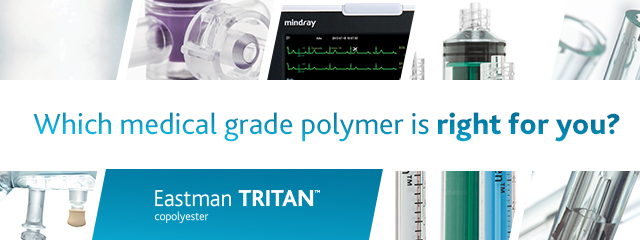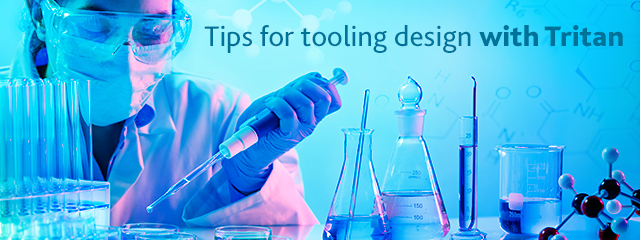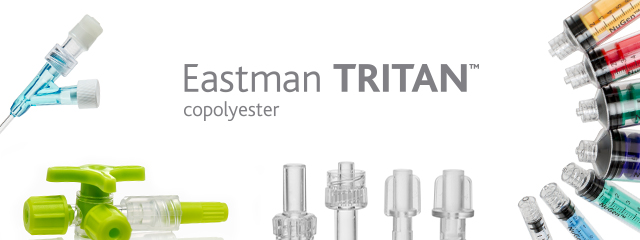How material choice impacts IV pump failures

NOTE: We appreciate you being part of our TritanMoldIt community! To ensure we are covering the information you need to best serve your customers and advance your business, we invite you to fill out this brief survey. As a thank you, you will have the option to be entered in a drawing for an Amazon Echo Show!
In examining why devices fail, it’s crucial to understand what happens when they are exposed to disinfectants and other harsh chemicals during cleaning. Constant exposure to many of these chemicals can damage a device’s structure — causing cracks, crazing, discoloration, and stickiness — and lead to compromised device performance, longevity, and ultimately, safety.
- Read more about How material choice impacts IV pump failures
- Log in or register to post comments
Improving medical device cleanability and durability

NOTE: We appreciate you being part of our TritanMoldIt community! To ensure we are covering the information you need to best serve your customers and advance your business, we invite you to fill out this brief survey. As a thank you, you will have the option to be entered in a drawing for an Amazon Echo Show!
- Read more about Improving medical device cleanability and durability
- Log in or register to post comments
Working together to solve medical device challenges

Molders and brand owners come to us for many different reasons during the developmental journey of a medical device.
• You may have a totally new device and want the best-fit polymer to optimize its performance advantages.
• Your current material may not have the chemical resistance and toughness to meet changing hospital disinfectant protocols and more powerful drugs and carrier solvents.
• Recent regulations may be driving the need for more compliant materials.
Whatever the challenge, working with Eastman lets you access technical expertise and support every step of the way—to help position your device for end-state success.
By collaborating early and often during product development and manufacturing, we can help you work with product engineers, toolmakers, and downstream assembly partners to bring your project to market efficiently and profitably.
Here are a few of the benefits of working together with Eastman:
- Read more about Working together to solve medical device challenges
- Log in or register to post comments
An innovative solution to medical device housing failure

As healthcare facilities ramp up the use of aggressive disinfectants, traditional plastics are feeling the strain. It’s all too common to see device housings become sticky; wear thin in high-touch areas; or crack, crumble, or shatter after only a few months of service. The issue? Devices that were designed just a few years ago are typically made with materials that lack the right combination of impact strength and chemical compatibility with today’s stringent cleaning protocols.
Eastman Tritan™ copolyester is an excellent choice for medical housings due to its superior toughness and high chemical resistance. Using Tritan in your device can also help prevent costly repairs and replacements, keeping patients safe and customers happy.
- Read more about An innovative solution to medical device housing failure
- Log in or register to post comments
Why should you choose Eastman medical grade polymers?

You want to create medical devices and packaging that ensure patient safety and provide long-lasting reliability. To accomplish that, you have to choose high performance medical grade materials. Manufacturers who specify medical grades of Eastman Tritan™ copolyester not only get access to advanced, high-quality raw materials but also to a strong level of support throughout the regulatory journey to commercialization of a new product.
By specifying Eastman medical grade polymers, you get help with:
By specifying Eastman medical grade polymers, you get help with:
- Biocompatibility
- Sterilization
- Quality systems
- Dedicated regulatory support
- Read more about Why should you choose Eastman medical grade polymers?
- Log in or register to post comments
Overmolding with Tritan

Using overmolded soft-touch materials can provide many functional and decorative benefits to items made from rigid thermoplastics. Eastman Tritan™ copolyester demonstrates exceptional adhesion with commercial grades of TPE. When selecting the TPE you want to use, make sure it is formulated for use with a copolyester substrate.
Consider these factors for part design:
Consider these factors for part design:
- Optimize part and TPE thickness for adhesion and dimensional stability. If the TPE thickness is in excess of the Tritan part thickness, you could see warpage when you remove it from the mold. Use a substrate thickness twice that of the TPE.
- Incorporate mechanical interlocks to improve TPE adhesion and promote part durability. Mechanical interlocks are important for thin TPE layers and very demanding fitness-for-use requirements.
- Read more about Overmolding with Tritan
- Log in or register to post comments
Which medical grade polymer is right for you?

We know that material choice is a crucial component of any medical device or device housing. When you’re deciding what medical grade polymer you need for your next project, consider these criteria:
- Does it make the grade?
- Will it match the application?
- Read more about Which medical grade polymer is right for you?
- Log in or register to post comments
Tips for tooling design with Tritan

What makes for effective molding of Eastman Tritan™ copolyester? Reviewing all aspects of design—from concept to secondary operations—early on in the process is crucial to end-stage success.
Tooling design review is one important step in the process that will help determine what type of gating system is right for your device. Here are four quick tooling design tips for injection molding with Tritan:
Tooling design review is one important step in the process that will help determine what type of gating system is right for your device. Here are four quick tooling design tips for injection molding with Tritan:
- Proper gating selection
Select a compatible gating style for the selected resin. Most conventional cold gating styles work well with Tritan copolyesters, including sub, pin, fan, edge, sprue, and diaphragm gates.
- Design tooling with good cooling/thermal control
Copolyesters require good thermal control throughout the cavity for optimal processing.
- Design tooling with a plan for venting
- Read more about Tips for tooling design with Tritan
- Log in or register to post comments
Navigating the complexities of compatibility with oncology drugs

The need to mitigate infection risks and enhance patients’ safety and comfort has significantly increased the demand for higher-performing plastics with improved chemical resistance. Many polymers commonly used in drug delivery devices simply do not hold up to modern oncology chemotherapies. After exposure to chemicals in the medical environment, devices made with these polymers can experience environmental stress cracking or premature failure in the presence of applied or residual stress.
Broken devices put patients at risk. What’s more, regulatory agencies may tell manufacturers to stop using certain materials when device performance or life cycle is compromised.
- Read more about Navigating the complexities of compatibility with oncology drugs
- Log in or register to post comments
Eastman Tritan™ copolyester—superior attributes for medical devices

Eastman Tritan™ copolyester is raising the bar for durability and cleanability in medical devices and housings. BPA-free Tritan’s attributes include exceptional clarity, toughness, improved heat and chemical resistance, and more. It’s also easy to process due to its unique chemical makeup relative to traditional thermoplastics. This blend of processing and performance properties provides greater advantages compared with other commonly used polymers. Available in clear and opaque formulations, Tritan offers many benefits to enhance innovative device designs:
Clear formulations of Tritan
- Greater toughness, heat resistance, processability, and design freedom
- Read more about Eastman Tritan™ copolyester—superior attributes for medical devices
- Log in or register to post comments





 Close
Close


